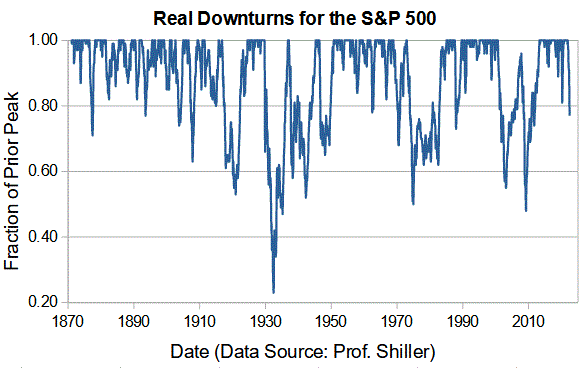|
|||||
|
|||||
|
Another bear. Oh, bother! Oh, bother! We've fallen into a mess of a bear market. But Pooh Bear is really concerned about the price of honey because his last visit to the supermarket was distressing. It's not just honey because prices are marching higher for all manner of goods and services. The inflation rate jumped to 8.6 per cent in the U.S. based on the latest year-over-year figures. That's well above the average annual inflation rate of 2.1 per cent since 1871. The Federal Reserve responded to the inflationary surge by boosting its benchmark rate several times this year. Further increases are widely expected. The bond market reacted poorly to these developments. The iShares Core U.S. Aggregate Bond ETF, a reasonable proxy for the overall U.S. bond market, saw its price fall 15 per cent from its 52-week high to its recent 52-week low. The unusually large decline shocked many bond investors. The stock market fared even worse as investors fret about a looming recession - or worse. The Vanguard S&P 500 ETF suffered a 24-per-cent decline from its 52-week high to its recent 52-week low, which puts it well into bear-market territory. (Bear markets are arbitrarily defined as periods when the honey in the market's pot shrinks by more than 20 per cent.) It's all a little reminiscent of the hard times seen in the 1970s when stocks floundered as inflation and high interest rates plagued the economy. I hope we will avoid a repeat of that unfortunate period but I'm less than optimistic about the stock market's near-term prospects. Problem is, bear markets have a habit of lingering for many months - or years. Before delving into bear markets of the past, I want to strike a more hopeful note by observing the market's positive long-term trend. After all, the S&P 500 climbed by an average of 9.1 per cent annually from early 1871 through June, 2022, according to data collected by Robert Shiller, a Yale professor of economics. It's also important to account for inflation given its recent surge. The S&P 500 gained an average of 6.9 per cent annually since 1871 after adjusting for inflation, which is still a remarkably good result. Now think back to prior U.S. downturns. You might first point to the 1929 crash as the granddaddy of calamities because it produced the most dramatic decline in the past century and ushered in the Depression of the 1930s. It might surprise you to learn that the 1929 downturn was not the longest on record because the market recovered in 1936, including reinvested dividends and adjusting for inflation. Similarly, the inflation-fuelled downturn that started in 1973 and lasted all the way until 1985 was the second-longest on record. Retirees will have experienced the longest market downturn because it occurred when the internet bubble burst in 2000. The S&P 500 continued to fall into 2003 and nearly recovered - in inflation-adjusted terms - before the financial crisis hit in 2008. Investors had to wait until 2013 for the market to eclipse its old highs. The period also produced the second-worst loss because the S&P 500 fell 52 per cent from its high in 2000 before hitting bottom in 2009. You can see the influence of past bear markets in the accompanying graph, which shows how far the market declined from its prior peaks. It's based on Prof. Shiller's data and uses inflation-adjusted monthly returns that include dividend reinvestment. (The returns don't include taxes or trading frictions.)  The question that currently faces us is whether we're in the early stages of a long and bruising bear market like that of 1973 or a relatively short downturn like the one seen in 1987. If it's a big one, the market would have to fall about 36 per cent, 39 per cent or 70 per cent from its level at the end of June to match the magnitude of the crashes that started in 1973, 2000 and 1929, respectively. Naturally, one might contemplate an even worse result. For my part, I think this bear will - like most others - growl for a while longer. Mind you, investors should ready themselves to nibble on bargains as they arise because fortunes can be made in bear markets. Just be mindful that diving in too early might land one in a very sticky situation. First published in the Globe and Mail, July 04 2022. |
|||||
| |||||
| Disclaimers: Consult with a qualified investment adviser before trading. Past performance is a poor indicator of future performance. The information on this site, and in its related newsletters, is not intended to be, nor does it constitute, financial advice or recommendations. The information on this site is in no way guaranteed for completeness, accuracy or in any other way. More... | |||||